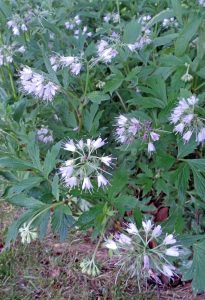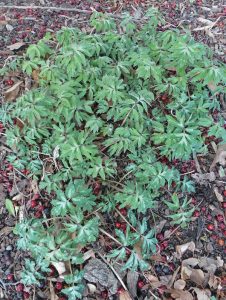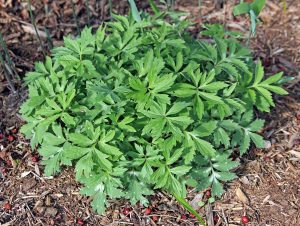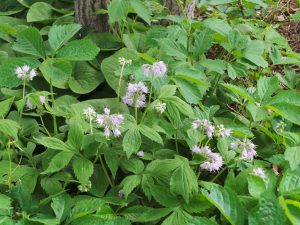
Virginia waterleaf, Hydrophyllum virginianum, is a native herbaceous perennial in the Hydrophylloideae (but often listed in the Hydrophyllaceae (waterleaf family) which was demoted to this subfamily of Boraginaceae (borage family)) found in moist, wet wooded areas of eastern North America from eastern Canada to the eastern part of the Dakotas and south to Missouri and North Carolina in Zones 3-6. Also called eastern waterleaf, Shawnee salad, and other common names, it is easily distinguished from other Hydrophyllum species (most of which do not occur in Wisconsin) by several characteristics of the stems, leaves and flowers. Native Americans used the plant medicinally.

The plants grow from a tuft of fibrous roots and rhizomes to form large colonies 1-2½ feet tall. The broadly oval to triangular leaves are pinnately divided almost to the midrib into 3-7 lobes with acute tips and coarsely toothed margins. The leaves may be solid green but the earliest leaves to emerge will develop white spots to varying degrees that resemble water stains on the upper surface as they age (this doesn’t occur on later leaves). The plants begin to senesce in early summer and disappear later in the year. The only other species in Wisconsin, great waterleaf, H. appendiculatum, is found primarily in the southwestern part of the state and has more rounded leaves with 5-7 shallow, palmately-divided lobes.

Flowers appear in mid spring to early summer (a little later than most spring-blooming wildflowers in woodlands) on erect leafless peduncles extending from the upper stems above the leaves. Each peduncle produces a dense terminal spherical cyme about two inches across containing 8-20 flowers. Each small flower has a hairy green calyx, a tubular to bell-shaped corolla with five lobes, five conspicuous protruding hairy stamens with pale yellow tips that turn purplish-brown with age, and a slender style divided at the tip. The blossoms may be white, pink, pale blue or light purple. The flowers are pollinated by bumblebees, small carpenter bees, and other long-tongued bees feeding on the nectar – including the native waterleaf cuckoo bee which feeds only on plants in the genus Hydrophyllum – and are visited by other bees and flies which consume the pollen.

Flowers are followed by seed capsules. When ripe the capsules split open to release the small seeds. It self-seeds readily.


This native perennial prefers shady to partly shady sites (but tolerates full sun) and loamy soil rich in organic matter. It can be a good addition to woodland gardens but spreads aggressively, so is not a great choice for small landscapes. Plants can be dug out but the relatively fragile green or reddish green stems break easily, leaving the extensive root system intact to regrow if not done carefully. It is a good plant to quickly fill bare areas and help reduce soil erosion, especially in woodland areas where invasive buckthorn has recently been removed. It has few pests but deer may graze the foliage. It is easily grown from seed, flowering in the second or third year.

As a native woodland plant, it is commonly found in association with other woodland species including white baneberry (Actea pachypoda), wild columbine (Aquilegia canadensis), wild ginger (Asarum canadensis), blue cohosh (Caulophyllum thalictroides), dutchman’s breeches (Dicentra cucullaria), trout lilies (Erythronium spp), wild geranium (Geranium maculatum), false Solomon’s seal (Maianthemum racemosum), Virginia creeper (Parthenocissus quinquefolia), woodland phlox (Phlox divaricata), May apple (Podophyllum peltatum), and early meadow rue (Thalictrum dioicum).
– Susan Mahr, University of Wisconsin – Madison
Ask Your Gardening Question
If you’re unable to find the information you need, please submit your gardening question here:





 ▶︎ Watch: Fall Bulb Planting
▶︎ Watch: Fall Bulb Planting Aster, Symphyotrichum spp.
Aster, Symphyotrichum spp. Fascinating Fasciation
Fascinating Fasciation Alternatives to Lawn: Groundcovers
Alternatives to Lawn: Groundcovers


